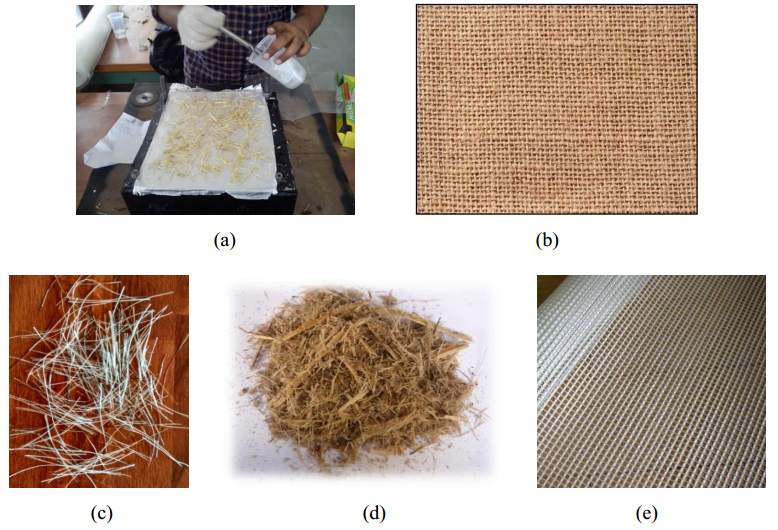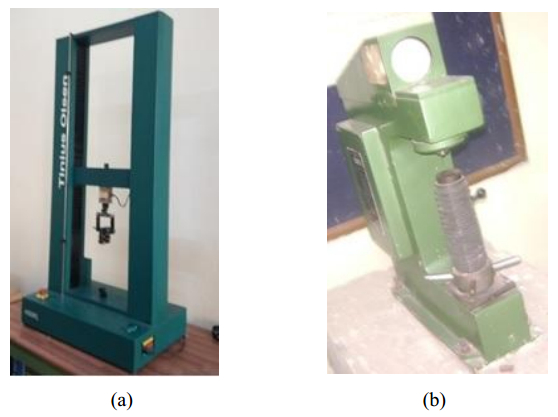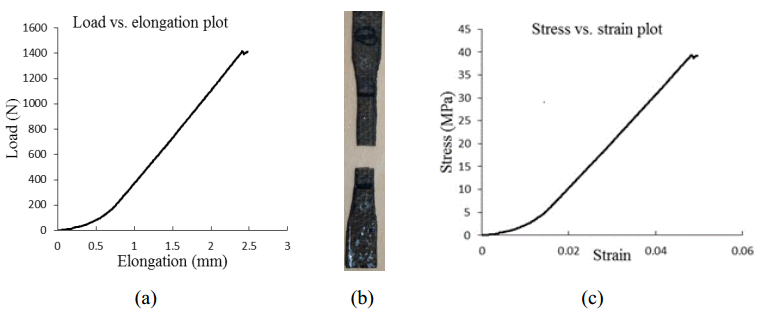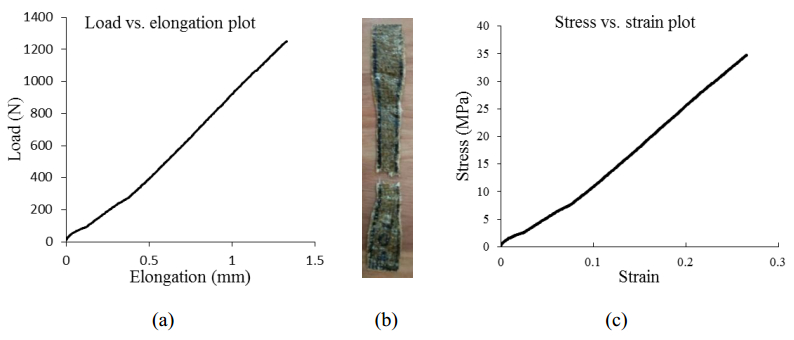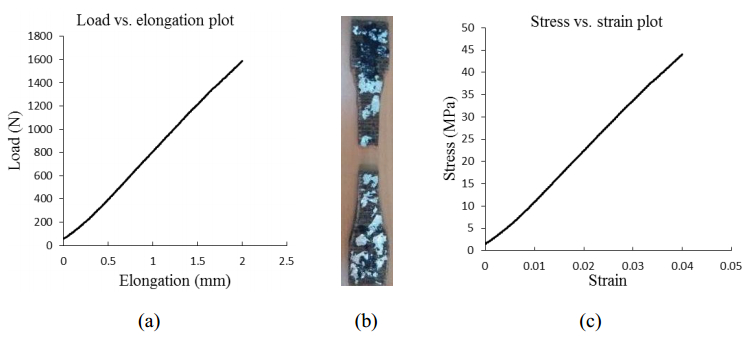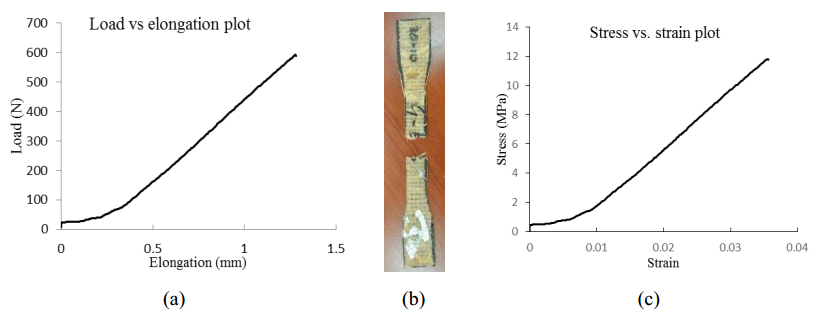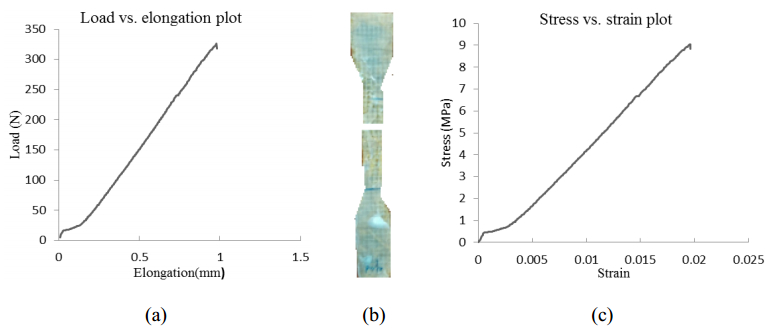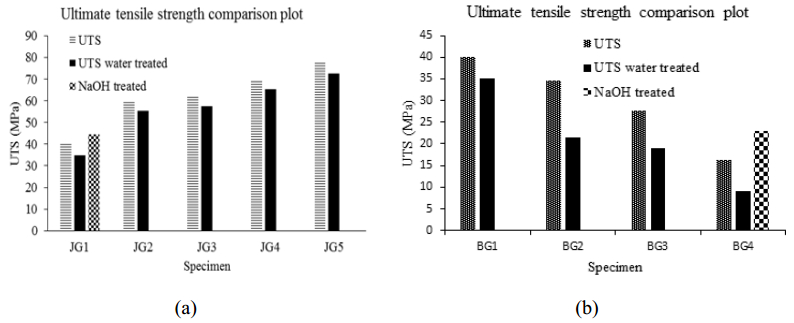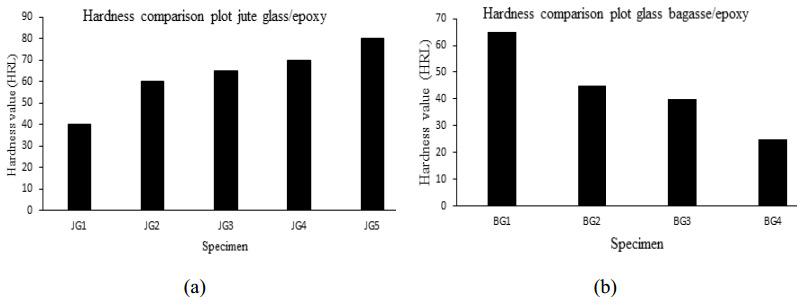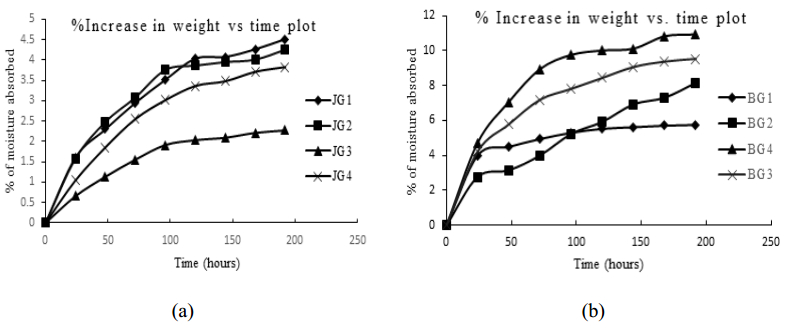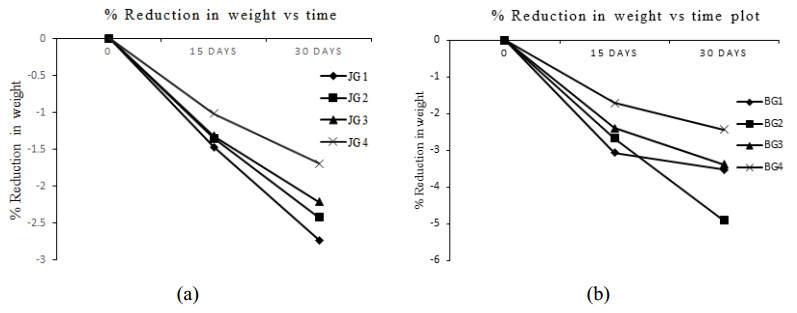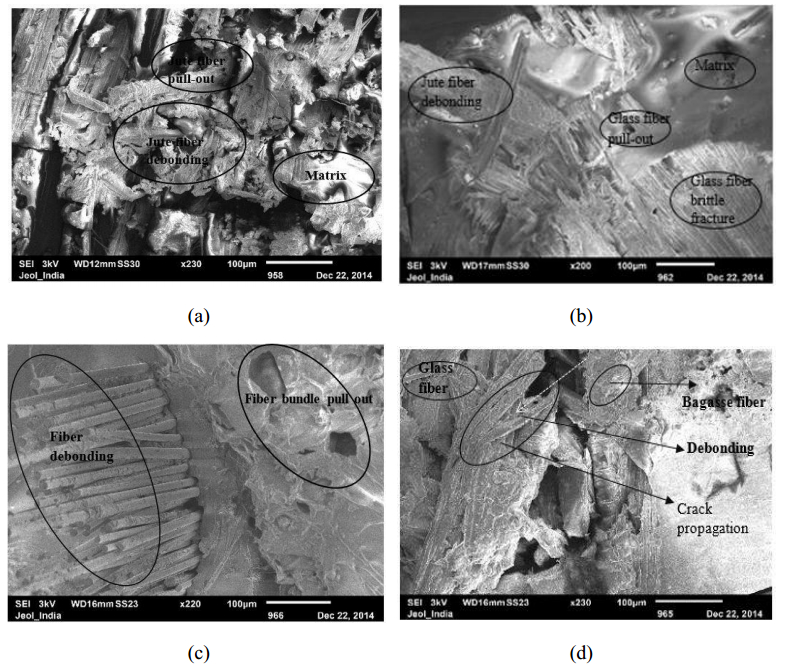1. Introduction
Fiber reinforced polymer composites comprise of fiber as the reinforcement which satisfy the desired conditions, influence and improve the desired properties whereas these reinforcements are bound together by the matrix. Fiber-reinforced composites are made from several layers of unidirectional (UD) tapes preimpregnated within a matrix material. Nowadays fiber reinforced composites are being used as a substitute to metals in a wide-ranging area like aerospace, automobiles and defence because they possess improved mechanical properties, such as high specific stiffness and high strength, high strength to weight ratio and resistance to corrosion by environment [1,2]. Fibers used in the composites can either be synthetic or natural, some commonly used synthetic fibers for composites are glass, aramid and carbon, whereas the matrix is constituted by epoxy which is a polymeric compound. The most commonly used synthetic fiber for reinforcement is the glass fiber which is basically super fine fiber of glass. They have several types such as E-glass fiber, S-glass fiber etc. depending on their strength and usage [3]. E-glass fiber was developed for insulation purposes but due to its very easy availability and low cost make its use ideal as reinforcement in composites. Amongst all reinforcing fiber, natural fibers have gained popularity as reinforcements in polymer matrix composites and due to growing global environmental problems and ecological risks, and natural fiber reinforced polymer composites have become an important area for research. The main advantages of natural fibers are their availability, biodegradability, renewability, low cost, low density, high specific properties [4,5,6]. Natural fibers such as bamboo jute, coir, sugarcane bagasse, sisal, banana and wood fiber have gained significance in use as a substitute to synthetic fiber [7]. Jute fibers are easily available in fabric and fiber forms and this fiber is the most promising reinforcement material due to its high content of cellulose (61–72%), hemicellulose (14–20.4%), lignin (12–13%) and pectin (0.2%) [8]. Bagasse is the sugarcane waste left after the extraction of juices product. The bagasse fiber has fairly good mechanical properties; its biggest advantage is that it is available freely and easily as by product of sugar manufacturing industry. Despite these advantages, there are some drawbacks also like their hygroscopic nature, poor wet ability and low thermal stability [9]. To overcome these drawbacks, natural fibers are often combined with synthetic fiber resulting in a hybrid composite.
A hybrid composite is an amalgamation of two or more different types of fibers in which one type of fiber reduces the drawbacks of another fiber. Hybridization aims at creating a new material that will preserve the benefits of its constituents but not their limitations.
Hybrid composites are often composed of synthetic and natural fiber as the reinforcing members [10]. Glass-jute and glass-bagasse hybrid composites are some of the popular hybrid composites in used nowadays [11,12]. Hybrid composites have gained popularity for use in applications like wall partitions, packaging materials, automobile interior parts like inner fenders and dashboard, lamp shades, floor tiles, etc.
Hossain et al. [13] have studied the effect of fiber orientation on the tensile properties of jute epoxy composites and reported that varying the fiber orientation affects the longitudinal and transverse tensile strengths. Rahman et al. [14] evaluated that with increasing the fiber loading, there is a gradual increase in the strength and hardness of jute fiber composite. Ramesh et al. [15] have done comparative evaluation on properties hybrid glass fiber-sisal/jute reinforced epoxy composites and thus concluded how the glass fiber affects the properties of natural fiber composites. Singh et al. [16] evaluated the mechanical properties of bagasse-glass fiber reinforced composite and found out that mixing of bagasse with glass fiber improves the modulus of elasticity. Addition of bagasse fiber decreases the ultimate tensile strength. But addition of glass fiber further increases the ultimate tensile strength in comparison to commercially available bagasse-based composites.
Cao et al. [17] studied the mechanical properties of biodegradable composites reinforced with bagasse fiber before and after alkali treatments and found that mechanical properties of the composites made from alkali treated fiber were superior to the untreated fiber. Perceiving the work already done in this area, this research work aims to determine the mechanical properties of jute-glass/epoxy and bagasse-glass/epoxy hybrid composites along with their strength comparison. Also, the behaviour of these composites under different environmental conditions such as soil and water are also studied in detail. The effect of alkali treatment of natural fiber on mechanical properties of hybrid composite is also investigated for the purpose of clearly identifying the difference in strength between treated and untreated fiber reinforced hybrid composites. Finally, their surface morphological characteristics are studied to determine the causes of failure under the application of tensile loading.
2. Materials and method
2.1. Materials
In the present work, jute fiber, glass fiber and bagasse are used as reinforcement to prepare specimens of hybrid composite with epoxy as a matrix. Bagasse fibres were obtained from sugarcane factories while jute fibres were obtained by untangling ordinary jute rope purchased at a supermarket. The properties of the reinforcing fiber are mentioned in Table 1. Two different groups of hybrid composites, viz. jute-glass/epoxy and glass-bagasse/epoxy were manufactured and tested for their properties in the present investigation. In the jute-glass/epoxy hybrid composites, jute is used in the form of a mat as the primary reinforcement and chopped glass fiber are used as the secondary reinforcement, whereas in the glass-bagasse/epoxy hybrid composites, the glass fiber is used of a mat as the primary reinforcement and chopped bagasse fiber are used as the secondary reinforcement. The wt.% of the glass fiber, jute and bagasse fiber used in above the two groups of hybrid composites are distinct and are depicted along with their sample specifications in Tables 2 and 3. The epoxy percentage (wt.%) was kept constant and the fiber weight was varied to obtain the different composite configurations. The resin used is ARALDITE LY556 and Hardener is ARALDITE HY951. The various compositions are shown in the two Tables below.
Table 1. Properties of fibers.
| Fiber |
Tensile strength (MPa) |
Young's modulus (GPa) |
Elongation at break (%) |
Density (gm/cm3) |
| Bagasse |
290 |
17 |
- |
1.25 |
| Jute |
393–1035 |
26.50 |
1.50–1.80 |
1.30 |
| E glass |
3400 |
72 |
- |
2.5 |
Table 2. Composition of jute-glass/epoxy hybrid composites samples.
| Sample |
Epoxy (wt.%) |
Jute fiber (wt.%) |
Glass fiber (wt.%) |
| JG1 |
60 |
40 |
0 |
| JG2 |
60 |
30 |
10 |
| JG3 |
60 |
20 |
20 |
| JG4 |
60 |
10 |
30 |
| JG5 |
60 |
0 |
40 |
Table 3. Composition of bagasse-glass/epoxy hybrid composites samples.
| Sample |
Epoxy (wt.%) |
Jute fiber (wt.%) |
Bagasse (wt.%) |
| BG1 |
60 |
40 |
0 |
| BG2 |
60 |
30 |
10 |
| BG3 |
60 |
20 |
20 |
| BG4 |
60 |
10 |
30 |
2.2. Manufacturing routes
Before the process of manufacturing of composite plates, a steel mould was prepared by means of which further the hybrid composite plates were prepared. The process used for the manufacturing of the hybrid composites is the hand lay-up technique, which is a simple and effective method. The hand lay-up process as shown in Figure 1a consists of the following steps. Initially a release agent, i.e., wax is spread evenly on the base plate of the mould so that the plate does not stick to the mould, then after a layer of epoxy was applied to the base plate. After the application of epoxy, the jute fiber mat which was cut into dimensions of 280 mm × 300 mm was laid on top of the base plate and chopped glass fiber (Figure 1c) were spread evenly on top the jute mat. Then another layer of epoxy was applied and spread with the help of a roller to ensure proper distribution of the epoxy and preventing the formation of air bubbles. Successively three more layers of jute mat (Figure 1b) and glass fiber and epoxy were added to obtain the hybrid composite plate. After the process of laying up of materials was completed, the mould was closed by applying pressure to the top plate and the setup was left for curing for 48–72 hrs. After curing the plates were removed from the mould and further cured in an oven at 60 ℃ for 3–4 hours, subsequently the composite plate was finally cured. The process described above was used for the manufacturing of jute-glass/epoxy hybrid composite, nonetheless for manufacturing the glass-bagasse/epoxy hybrid composite, the process remains similar with the main difference that the glass fiber is used in the mat form (Figure 1e) while the bagasse is in finely chopped into it (Figure 1d).
2.3. Methods
Once when the hybrid composite plates were prepared, subsequently the samples were prepared according to ASTM standards. Various tests were performed to investigate the mechanical properties of the hybrid composites. Tensile tests were performed to determine the tensile strength of the composite, whereas the hardness test was carried out using Rockwell hardness testing machine to determine the hardness of composite. Also, the moisture absorption test was performed to obtain the moisture absorption capacity. Further degradation test was performed to investigate the degradability of the hybrid composite by burying the samples in the soil having some moisture for certain periods of time. Moreover, the effect of alkali on the performance natural fiber was studied by treating the natural fiber with sodium hydroxide solution (NaOH) and then manufacturing the composite plates with the treated fiber and determining the mechanical properties of the composite [18,19,20,21]. Finally, the surface morphology of the composite is determined using the SEM.
3. Properties test
The experimental investigation which includes tensile and hardness tests respectively were carried out on specimens in accordance to ASTM standards. Five specimens per test were tested and the mean value of the results obtained was used. The tensile tests have been conducted on a computerized tensile Testing Machine by Tinius Olsen as shown in Figure 2a, while the hardness test was performed on a Rockwell hardness testing machine (Figure 2b) with a steel ball indenter having a ball diameter of inch, and the load applied is 60 Kgf.
3.1. Tensile test
The tensile tests of the specimens in accordance with ASTM D 638 were performed in a tension machine (Tinius Olsen) driven at gauge length of 50 mm with a crosshead speed of 2 mm/min. The length, width and thickness of the samples were kept respectively as 50 mm, 20 mm and 3 mm as shown in Figure 3. The tensile tests were conducted on flat beam specimen with a uniaxial load applied at one end.
3.2. Hardness test
Indentation hardness measures the resistance of a sample to material deformation due to a constant compression load from a sharp object. Small samples (Figure 4) as per ASTM D785 standards with dimension 10 mm × 10 mm were cut from the hybrid composite plate and were loaded into the hardness tester. The steel ball indenter indented the surface of the sample and required hardness value was obtained, on "L" scale of Rockwell hardness.
3.3. Moisture absorption
Moisture absorption studies were performed according to the ASTM D570 standards. The initial weights of the samples were taken and then after the samples were immersed into normal water. After 24 hours, the samples were taken out from the water and surface moisture was removed. Subsequently the samples were reweighed to the nearest of 0.001 mg. The samples were regularly weighed over the interval 24, 48, 72, 96,120,144,168,192 hours respectively [21]. The weight gain in percentage of the samples was measured at regular time intervals. The percentage change in weight or the weight of water gained is estimated as:
where, Wt = weight at time t, W0 = initial weight and W = weight of water absorbed.
3.4. Degradability test
The degradability test was carried out for the purpose of assessment of the effect of natural agents like soil and moisture on the performance of hybrid composite and thus estimates its performance under such conditions. Initial weight of composite sample was taken and then the composite samples were buried in soil (having at least 25% moisture) for different periods of time [22,23,24]. After a certain period, i.e., 15 days and 30 days, samples were withdrawn carefully, washed and dried, and then the final weight was measured. The difference between the initial and final weights articulates the degradability of the composite.
3.5. Alkali treatment test
In this case, the natural fibers were treated with 10% NaOH (Sodium Hydroxide) solution and were soaked in the solution for 2–3 hours, then after taken out of the solution and were washed to remove excess alkali and further were dried for composite manufacturing. After treatment, semi crystalline and amorphous portions in the fiber, such as hemicellulose, lignin and other alkali-soluble fraction, were preferentially removed as it cleans fiber surface removing impurities, waxy substances and natural oils. An increase in the number of free hydroxyl groups in the fiber surface improves the adhesion with resins.
4. Result and discussion
In this section, the results obtained from the various tests performed on the hybrid composite specimens of jute-glass/epoxy and glass-bagasse/epoxy hybrid composites are discussed in detail. The stress strain curves which were derived from the tensile tests of the specimens were discussed to understand the mechanics behind the fracture of the composite specimen, the tensile behaviour of water treated composite is also studied and its comparison is made with the untreated composite. The hardness of the composite specimen was investigated and the variation in hardness with the composition of reinforcement has been discussed in detail. The degradability of the composite specimens under normal soil condition is studied and also the moisture absorption capacity of the specimen is discussed in order to determine the effect of moisture on the performance of composite. The effect of alkali treatment of natural fiber on the tensile strength of composite is evaluated and compared with that of the untreated one.
4.1. Tensile test
The load elongation curves were obtained from the tensile testing machine while the stress strain curves were obtained by dividing the load by original cross section area, i.e., 36 mm2 for stress and the dividing the elongation by original gauge length, i.e., 50 mm for strain.
4.1.1. Specimen JG1
Figure 5a, c respectively shows the load elongation and stress strain curve for the specimen JG1. The ultimate tensile strength of the sample was observed as 40 MPa. The stress varies linearly with respect to strain and no yielding is observed however, the composite finally fractures at its ultimate tensile strength. All of fibers don't fail at a specific load level rather; fiber fails in a series of failure events with the weakest fiber breaking first. The graph shows the brittle nature of the composite as jute fiber used in composite undergoes brittle failure. The curve obtained is smooth indicating uniform distribution of load in the composite and breaking of fiber is continuous hence no peaks occurred in the graph.
4.1.2. Water treated specimen
The decrease in mechanical properties with increase in moisture content is an effect of the hydrogen bonding between the water molecules and cellulose fiber. Once the moisture penetrates inside the composite materials, the fiber tends to swell. Natural fibers are hydrophilic in nature with many hydroxyl groups (–OH) in the fiber structure which attach to water molecule by hydrogen bond and interface between fiber and epoxy gets weaken due to which mechanical strength of composite decreases significantly. Figure 6a shows the load elongation curve while the Figure 6c shows the stress strain curve obtained from it. The ultimate tensile strength of the sample is 34.75 MPa. The stress varies linearly with respect to strain and no yielding is observed and the composite finally fractures at its ultimate tensile strength by brittle failure.
4.1.3. NaOH treated specimen JG1
The alkali treatment is an effective method to improve the mechanical properties of natural fiber, but its success depends on many variables, hence it becomes difficult to predict the effect over a particular natural system. The tensile test was performed on the NaOH treated composite specimen and its tensile strength was found to be increased. After treatment, semi crystalline and amorphous portions in the fiber, such as hemicellulose, lignin and other alkali-soluble fraction, were preferentially removed.
It cleans fiber surface removing impurities, waxy substances and natural oils and increases the number of free hydroxyl groups in the fiber surface, which improves the adhesion with resins. It also produces a rough surface topography, facilitating mechanical interlocking which leads to an improvement in fiber-matrix adhesion and leads to better strength. The ultimate tensile strength of the sample was found to be 44.4 MPa, which is 11% higher than the untreated jute composite. The graph (Figure 7a) shows brittle nature of the composite as jute fiber used in composite undergoes brittle failure. The curve (Figure 7c) shows a sudden rise due to the fact that fiber bundles are breaking together.
4.1.4. Specimen BG4
In this case, the weight% of the bagasse fiber was increased from 20 to 30%, hence the overall strength of composite decreases from 27.7 to 16.6 MPa. The mode of failure was brittle fracture as no yielding was observed. Figure 8c shows the stress strain curve; the ultimate tensile strength comes out to be 34.54 MPa. The stress strain curve tells us that the resulting composite is a brittle material as no yielding is observed. In this case, 30% bagasse and 10% glass fiber was used to make total 40% reinforcement. When the lamina is subjected to increasing tensile force in longitudinal direction, all fiber does not fail at a specific load level rather; fibers fail in a series of failure happenings with the weakest fiber breaking first. This is because fiber strength is a statistically distributed function. Once number of broken fiber exceeds a certain number, the composite may become too weak at a specific cross-section to bear any further increment in load and final failure occurs.
4.1.5. Water treated specimen BG4
In this case as shown in Figure 9, decrease in mechanical properties with increase in moisture content is observed due to effect of the hydrogen bonding between the water molecules and cellulose fiber. Natural fibers such as jute and sugarcane bagasse tend to show high moisture absorption. This leads to a degraded interfacial bonding between the fiber and matrix, and a hence a decrease in the mechanical strength is observed.
4.1.6. Specimen of NaOH treated BG4
The stress strain curve as shown in Figure 10c was generated to evaluate the tensile strength of the alkali treated bagasse-based composite and it was found that the tensile strength of the alkali treated bagasse-based composite with composition of glass fiber as 10% and bagasse as 30% to be 23 MPa which is higher than the original untreated BG4 composite of 16.6 MPa.
The ultimate tensile strength graph (Figure 11a) shows that as the concentration of the glass fiber in the jute-glass/epoxy hybrid composite increases the ultimate tensile strength also increases due to the improved tensile strength of glass fiber and their better adhesion with the matrix. The graph also shows that water treatment has reduces the tensile strength whereas alkali treatment improves the tensile strength of the composites. The ultimate tensile strength graph (Figure 11b) shows that as the concentration of the bagasse fiber in the glass bagasse/epoxy hybrid composite increases the ultimate tensile strength decreases due to the poor tensile strength of bagasse fiber and their inferior adhesion with the matrix. The graph also shows that water treatment has reduces the tensile strength of the composite whereas alkali treatment improves the tensile strength of the composites.
4.2. Hardness test
In the first group of samples as shown in Figure 12a, i.e., jute-glass/epoxy sample JG1 has a hardness value of HRL 40 whereas the sample JG5 has a hardness value of HRL 80. The second group of composites (Figure 12b), i.e., glass-bagasse composites follow a similar trend with BG1 having hardness number HRL 65 and BG4 having hardness number HRL 25. The test results show that as the concentration of glass fiber in the hybrid composite increases the hardness value also increases as glass fiber possess greater hardness and show better adhesion to the matrix thus increasing the overall hardness of the composite.
4.3. Moisture absorption
The tendency of water absorption is mainly due to natural fiber. Jute is mainly built up with cellulose which is the hydrophilic glucan polymer. The elementary unit of jute is a hydro-d-glucose which contains three hydroxyl (–OH) groups and these hydroxyl groups in the cellulose structure account for the strong hydrophilic nature of jute.
As seen from Figure 13a, higher the jute content larger the water absorption. The graph shows that the specimen having the highest jute content, i.e., JG1, absorbs the most moisture and the specimen having least jute content, i.e., JG4, absorbs the least moisture. It can also be inferred that the initial water absorption rate is high as compared to water absorption rates at later stages. The water absorption per unit time decreases with time, although the overall water absorption increases. In case of glass-bagasse/epoxy hybrid composites, the tendency of water absorption is mainly due to the presence bagasse fiber. Bagasse is mainly built up with cellulose which is the hydrophilic polymer with the presence of a high –OH group percentage, thus showing low moisture resistance and the composite tends to swell and absorb huge amount of moisture. With time the point for –OH bond to attach becomes lesser and lesser, hence water absorption per unit time decreases with time, although overall water absorption increases. Figure 13b shows that the water absorption per unit time decreases with time although overall water absorption increases. Also, the water absorption tendency of the composite increases with increase in bagasse fiber content of the composite. The specimen BG1 absorbs least and BG4 absorbs maximum amount of water.
4.4. Degradability
The degradability of composite is simply the weight loss occurred in the specimen over a certain time period when kept inside the soil. Jute and bagasse are natural biodegradable fibers and these fibers are lignocelluloses based. The natural fiber absorbs water within a couple of minutes indicating a strong hydrophilic character. Cellulose has a strong tendency to de-grade when buried in soil thus during the soil degradation tests water penetrates from the cutting edges of the composites specimens which leads to the degradation of cellulose present in jute and bagasse; as a result, the weight reduces and mechanical properties of the composites decrease.
The graph (Figure 14a) for jute-glass/epoxy hybrid composite shows that the sample with the highest jute content, i.e., JG1, has lost maximum weight and is most degraded while the sample with minimum jute content, i.e., JG4, has lost the least weight. Similar characteristics are observed for the glass-bagasse/epoxy hybrid composites (Figure 14b). As the percentage of bagasse increases the degradability characteristic of the composite increase, due to increment of cellulose content.
5. Scanning electron micrograph (SEM)
In order to determine the pattern of deformation and failure mode of the above tested composite samples, scanning electron microscopy (SEM) images were collected on a high capacity JEOL JSM-6010LA. The composite samples after the tests were cut to specified dimensions cleaned properly and mounted cross section wise on the SEM. SEM micrograph of the tensile fractured surface of the sample JG1 presented in Figure 15a shows that the failure of the specimen is mainly brittle failure and the jute fibers are debonded from the matrix and at some place fibers are also being pulled out the matrix. Figure 15b shows that failure of the specimen is mainly by glass fiber fracture and jute fiber are being pulled out the matrix. Since the tensile strength of glass fiber is more, higher tensile forces are required to fracture glass fiber and pulling them out from the matrix. The interfacial adhesion between glass fiber and matrix is much better when compared with that of jute fiber and matrix. The combined effect of fracture of most of the glass fiber and pulling out of jute fiber leads to higher tensile strength of the hybrid composite.
Figure 15c features the cross section of the fractured surface of sample BG2. The failure pattern such as fiber bundle pull out (dark pits) and fiber debonding can be seen easily reflects the major characteristic of brittle fracture. Fiber bundle pull out occur when fiber bundles got pulled out of the surface of the matrix of composite and leave pits. Fiber debonding occurs whenever fiber try to expand themselves more than the matrix allow them due to application of loads, in this case the matrix and fiber got separated from each other and fiber debonding occur. These characteristics denote that the failure mode is tensile brittle type. Different fracture characteristics viz. debonding and micro crack propagation can be seen for sample BG4 in Figure 15d. These are the characteristics of brittle fracture hence; it denotes that the mode of failure is brittle fracture. In this case, debonding of bagasse fiber can be seen easily due to major composition of bagasse fiber which gets debonded easily.
6. Conclusions
The present work is oriented towards understanding the response of jute-bagasse-glass/epoxy-based hybrid composite under tension and indentation loading. The effect of alkali treatment, soil degradation and water absorption on the strength of hybrid composite was compared and discussed in detail for individual cases. The reinforcements used in the present study have been broadly classified in two categories viz. jute-glass (JG) and bagasse-glass with epoxy as a matrix material. Surface morphology was studied to find out the different crack and failure mechanism occurred during the testing. The work was focused to understand the overall mechanical and physical behaviour of natural fiber reinforced composite in a real-world condition. The following conclusions are drawn from the analysis on the basis of experimental results:
1. The tensile strength of natural fiber reinforced hybrid composites increases as the weight% of glass fiber increases because UTS of glass fiber is far better than jute or bagasse. The strength of jute-glass hybrid composite is superior than the bagasse-glass hybrid composite as UTS of jute is higher to bagasse and the density of bagasse-glass/epoxy is lower than jute-glass/epoxy hybrid composite.
2. The strength of water treated hybrid composite decreases compared with untreated composite because of weakening of internal bonds in natural fiber and epoxy due to hydrogen bonding between water molecule and –OH group present in cellulose of natural fiber.
3. The strength of hybrid composite increases up to 10% when NaOH treated natural fibers were used to make the composite because after treatment, semi crystalline and amorphous portions in the fiber, such as hemicellulose, lignin and other alkali-soluble fraction, were preferentially removed. It cleans fiber surface removing impurities, waxy substances and natural oils. Increasing the number of free hydroxyl groups in the fiber surface improves the adhesion with resins.
4. As the concentration of glass fiber in the hybrid composite increases the hardness value also increases because glass fiber possesses greater hardness and shows better adhesion to the matrix thus increasing the overall hardness of the composite. The hardness of jute fiber hybrid epoxy composite is higher than the bagasse fiber hybrid epoxy composite for same weight% of jute and bagasse. It is because of the fact that the strength and hardness of bagasse fiber is lower than jute fiber.
5. The water absorption capacity of natural hybrid composite is larger than glass epoxy composite. Also, the water absorption capacity increases as the weight% of the natural fiber increases in the composite. The water absorption tendency in natural hybrid composites is mainly due to the cellulose content of the natural fiber. The –OH group present in the cellulose makes the jute and bagasse as hydrophilic in nature.
6. As the percentage of natural fiber increases the degradability characteristic of the composite increases due to augmentation of cellulose content. Cellulose has a strong tendency to de-grade when buried in soil as a result, the overall weight reduces and mechanical properties of the composites deteriorate.
7. The SEM images depict that the failure of the jute-glass/epoxy hybrid composite specimen is governed mainly by the glass fiber brittle fracture and jute fiber pull-out. The interfacial adhesion between glass fiber and matrix is much better when compared with that of jute fiber and matrix. Also, since the glass fiber has higher tensile strength, it shows brittle fracture and jute fiber are debonded and pulled out since they have lower tensile strength.
8. In case of bagasse-glass/epoxy hybrid composite specimen, the failure takes place by bagasse fiber being debonded and being pulled out of the matrix while the glass fiber undergoes brittle fracture, this is due to the fact that glass fiber possesses higher tensile strength than bagasse fiber, also glass fiber has better adhesion with the matrix compared with bagasse fiber.
Conflict of interest
There is no conflict of interest regarding the publication of this manuscript.









 DownLoad:
DownLoad: 